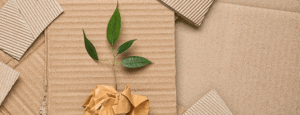Choosing a Sustainable Packaging Supplier
There are many ways to ‘go green’ with your packaging. But what are the most sustainable packaging options? And what needs to be considered when working with packaging manufacturers?
Consumers increasingly demand that the products they buy are packaged with sustainable materials. In response, companies must reevaluate their packaging materials and explore sustainable packaging solutions to boost brand loyalty.
Innovations in design, production, and recycling technologies continue to push the boundaries of what is possible for sustainable packaging. Better Solutions for the environment and your business’s sustainability.
- Right-sized packaging
- Alternatives to plastic
- Renewable materials
- Biodegradable
- Compostable
- Recycled content
Sustainability encompasses the life and death of the packaging.
To create product packaging sustainably, you must look at the entire life cycle. How it’s made. How it’s used. What happens to it after the product is removed or runs out. There are many choices to make – size, weight, design, materials, colors. Using raw materials and production processes that limit the environmental impact. And reducing the environmental footprint over time.
The Sustainable Packaging Coalition®, the leading voice on sustainable packaging, defines sustainable packaging based on criteria of:
- Beneficial, safe and healthy for individuals and communities throughout its life cycle
- Meets market criteria for performance and cost
- Sourced, manufactured, transported, and recycled using renewable energy
- Optimizes the use of renewable or recycled source materials
- Manufactured using clean production technologies and best practices
- Made from materials healthy throughout the life cycle
- Physically designed to optimize materials and energy
- Effectively recovered and utilized in biological and/or industrial closed loop cycles
Where to start.
Sustainability must be integrated into how we think, not just what we make. It must be built in from the very beginning of the packaging development cycle with product design and raw materials sourcing. When choosing a packaging supplier, transparency and accountability are important to understand the impact of your environmental footprint. A prospective vendor may claim their packaging is ‘green’ without detailing how.
Collaboration on packaging design and transparency of source materials are the keys to a successful packaging development effort and sustainable transformation. By working collaboratively, you and your packaging supplier can make a positive, meaningful impact.
Package Design. Conventional packaging designs are inefficient, using more materials than needed and relying on nonrenewable materials such as plastic. Sustainable packaging requires rethinking package design. Truly thinking outside the proverbial box. Thoroughness in evaluating each packaging component will ensure an overall sustainable design.
- Size
- Weight
- Format design
- Primary and Secondary packaging
- Reusability
- Stability
- Durability and Protection
- Transportation
- Safety
- Cost
Effective sustainable package design balances sustainability with the needs of functionality, branding, or logistics.
Materials Sourcing. At the heart of sustainable packaging is the sourcing and quality of the raw materials and the ecosystems in which they are produced. This requires knowing where the materials come from and that they are manufactured in a way that minimizes negative impacts on the environment.
When looking for sustainable packaging options, transparency of material composition is critical. To certify that the packaging is sustainably sourced and manufactured, request product-specific sourcing data from your packaging suppliers.
- Sourcing and compliance certificates
- Material property values
- Product specifications
- Chain-of-Custody traceability
- Safety data sheets
Paper. When possible, choosing paper-based packaging is safer for the environment because it’s naturally biodegradable and renewable. Further, products made with recycled paper content use less energy to manufacture and generate lower emissions. Recycling enables raw materials to be utilized again to keep products out of landfills.
However, there is a misconception that recycled paper should always be used. More recycled fiber is not always better for the environment – it depends on the packaging application. Each time paper is recycled, the fibers become shorter and weaker. Many paper products can be recovered an average of 4-6 times before their fiber strength is lost. Higher grades of paper for printing and packaging may take more energy to recycle used paper than to use virgin fiber from sustainably grown forests. That is why virgin pulp is introduced into paper production to maintain the strength and quality of the fiber.
Flexible packaging options have typically been limited to preformed plastic, film, or foil pouches; and many are manufactured with two or more materials that are too difficult or expensive to separate for recycling. But pouches can also be made from paper. Yes, paper! Specifically glassine, a supercalendered pulp-based material that is a sustainable alternative to plastics, films, and foils.
Responsible Forest Management. Forest certification programs provide supply chain assurance of responsibly sourced wood. When choosing paper, select a supplier supporting responsible forest management and certified to the Forest Stewardship Council® (FSC®) and the Sustainable Forestry Initiative® (SFI®) chain of custody standards. These certifications verify that the source of the wood supply is traced from the forest to the product.
Paper is only the start.
Individual components impact recycling and overall biodegradation. While the primary packaging substrate is a key factor for material sourcing, the components of the entire package need to be considered – adhesives, printing inks, coatings, laminates, window films.
Coatings. Misinterpretations exist about the sustainability of coated papers. The difference lies in finishes versus laminates. Paper coating materials play an important role to enhance the quality of paper. Coated paper is coated with a mixture of materials to improve gloss, brightness, smoothness, opacity, or other printing properties. With surface coatings, the papers can achieve near 100% biodegradaton; the overall decomposition process is unaffected.
However, polycoated paper contains plastic layers, laminates, or wax coatings. While these types of papers are used to improve functionality such as water resistance or tear strength, the plastic fragments are typically less biodegradable. Many plastic-coated paper products are coated with polyethylene, which has not been shown to biodegrade in a reasonable time.
Inks. Vibrant printing plays a key role in custom packaging and product branding. But not all inks are created equal. Many traditional printing inks are petroleum based, which release harmful volatile organic compounds (VOCs). Recyclable water-based and soy-based inks significantly lower the environmental impact over solvent inks. And soybeans are a highly sustainable crop.
Adhesives. Conventional solvent-based adhesives contain volatile organic compounds (VOCs) and do not easily biodegrade. Innovations in solventless adhesives further enhance the overall sustainability content of packaging. Repulpable adhesives dissolve completely in water during the paper repulping process, without leaving any residue behind. And renewable adhesives are derived from materials such as plants and beeswax, and have no petroleum derivatives in their formulations.
“Green” is not black and white.
When evaluating sustainable packaging materials, the terminology is confusing and often misunderstood. Is it recyclable? Compostable? Biodegradable? Made of recycled materials? Is that different from post-consumer waste? Request material statements of compliance or fiber content from your supplier to be sure.
For example, biodegradable and compostable are not the same. While composting and biodegrading processes involve the same action, the decomposition occurs in two very different ways. Compostable materials require a controlled setting in order to break down, whereas biodegradable materials break down naturally. A key difference is how long it will take for the product to biodegrade. Some products degrade in months, while others take years.
When shopping for sustainable packaging, the less time for biodegradation the better.
Finally, eco-friendly packaging doesn’t have to be brown.
Forget the brown bag experience you associate with ‘environmentally friendly’ packages. You don’t have to choose between sustainability and great packaging! You can create beautiful packaging with sustainability in mind. Glassine, embossing, textured paper stocks, and vibrant colors from soy-based inks create sustainable packaging products that are designed to be displayed. So what your customers see is perfectly on brand.
Let JBM help you plan and package for a greener tomorrow.
At JBM Packaging, we’re on a mission to help our customers evolve to plastic-free packaging alternatives. We help companies shift to non-plastic alternatives and reduce overpackaging. For 35 years we’ve focused on manufacturing packaging products with only pulp-based materials to sustain our natural resources. We’re dedicated to cultivating a Better World together.





